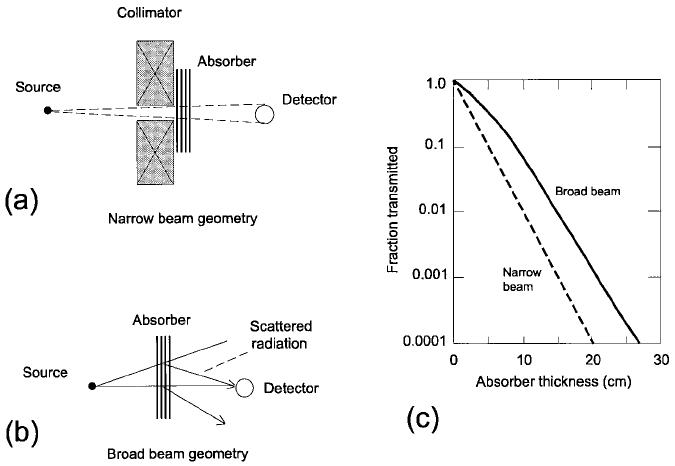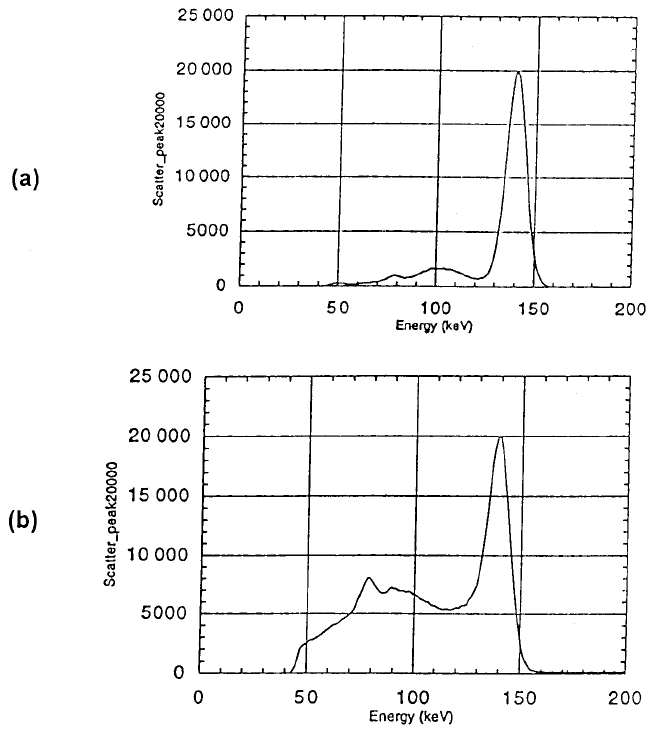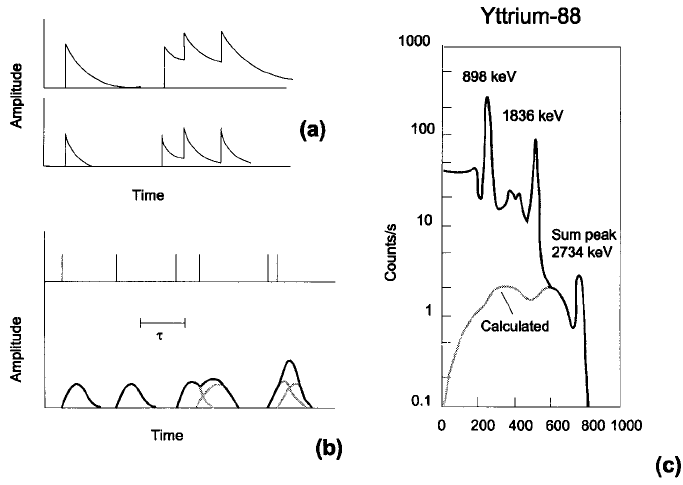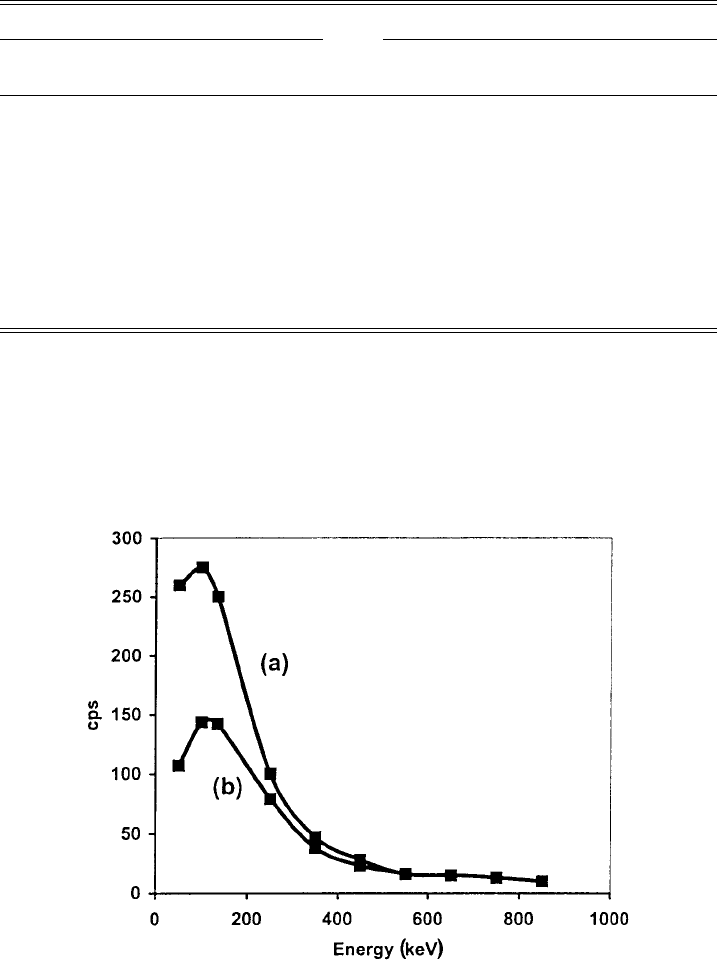Lowenthal G., Airey P. Practical Applications of Radioactivity and Nuclear Radiations
Подождите немного. Документ загружается.


geometry (Section 3.4.5). However, there are many applications when g rays
have to pass through attenuating material before reaching the detector, and
in such cases Compton scatter is unavoidable.
When g rays are scattered in low Z number materials (Z < 15), signi®cant
Compton scatter begins at energies above about 50 keV (Figure 3.7(a)), when
g rays de¯ected from the beam can be scattered back into the detector so
reducing the peak-to-total ratio.
If the intensities of g rays transmitted in broad beam geometry (Figure
4.6(b)) are to be measured reproducibly via the countrate in the full energy
peak, two points have to be noted. (1) Since Compton scatter reduces the
peak-to-total ratio of the spectrum, it must be kept constant during a series of
comparisons by ensuring a constant environment. (2) Results obtained using
published attenuation coef®cients, e.g. those shown in Figure 3.7(a), could
overestimate the attenuation since they assume narrow beam geometry.
Build-up is de®ned as the ratio of the g ray countrate following attenuation
in broad beam geometry (Figure 4.6(b)) to the countrate that would have
been observed for attenuation in narrow beam geometry (Figure 4.6(a)).
4.4 Gamma ray counting 111
Figure 4.6. Gamma ray attenuation in narrow and broad beam geometry. (a)
Narrow beam geometry. A collimator prevents g rays scattered out of the beam by
Compton interactions from reaching the detector. (b) Broad beam geometry when
Compton scattered g rays could be scattered back into the detector. (c) Gamma rays
attenuated in iron in both narrow beam and broad beam geometry, illustrating
build-up of the broad beam.

Build-up factors for various materials are available in the literature (e.g.
Shleien, 1992). These factors increase with the thickness of absorbing material
as shown in Figure 4.6(c) for iron. Every gamma ray scattered prior to
detection reduces the peak-to-total ratio in the spectrum as shown in Figures
4.7(a) and (b).
Figure 3.15 demonstrates the effect of a high rate of Compton scatter on
the appearance of spectra. The Compton region of the spectrum, i.e. the
Nuclear radiations: a user's perspective112
Figure 4.7. Pulse height spectra due to technet ium-99m g rays. Peak heights
were normalised to a maximum of 20 000 counts per interval. (a) Spectrum due to
a thin source in air and in narrow beam geometry, and (b) with the
99m
Tc
dissolved in a water phantom when the peak-to-total ratio is greatly reduced by
Compton scatter (courtesy of S. Eberl, Royal Prince Alfred Hospital, Sydney,
Australia).
section between the backscatter peak and the Compton edge (Figure 3.6(f ))
is, in this case, a much more prominent feature of the spectrum than the 411.8
keV full energy peak. In a scatter-free environment the peak-to-total ratio at
412 keV is close to 0.6 (Figure 4.5) whereas it is only about 0.12 in Figure
3.15.
4.5 Corrections and precautions, part 1
4.5.1 A summary
Results of measurements of ionising radiations are nearly always incom-
plete and could be misleading until corrected for a number of effects,
notably radionuclide decay and unwanted or lost counts. Here it is only
practical to deal with the most commonly occurring corrections which
include:
1. dead time corrections
2. corrections for pulse pile-up, random and coincident summing
3. decay corrections
4. corrections to account for unwanted radiations.
Corrections 1 to 3 will be dealt with in this section and the fourth group in
is covered in Section 4.6. The order does not imply an order of importance.
4.5.2 Dead time corrections
If nuclear radiations trigger a pulse counter, they initiate a train of events
which has to go to completion before the counter can respond to another
ionising event (Section 5.3.3). The time during which it cannot process
incoming radiations is known as its dead time. Ionisation chambers operating
in the saturation region (Section 5.2.1) are not subject to dead time as de®ned
here. Semiconductor detectors are not subject to dead time either, but they
are subject to pile-up and summing effects.
Ionisation chambers are not subject to dead time because the electric ®eld
across the chamber continues to collect ions formed in the gas regardless of
what went on before. Errors can occur if the ®eld is not strong enough to
collect all the ions before they recombine, so causing the extent of the
ionisation to be underestimated.
The dead times of GM detectors range from about 50 to over 300 ms
(Section 5.3.2). The dead times of proportional counters similar to those
shown in Figures 5.2 or 6.1 are likely to be in the range 2 to 4 ms (Section
4.5 Corrections and precautions, part 1 113
5.3.3). The dead time of NaI(Tl) crystals is only about 1 ms while that of
organic scintillators (Section 4.2.4) can be shorter than 0.1 ms.
If a radionuclide is available which has a well known and suf®ciently short
half life, one can measure the effective dead time for a detector as follows.
Beginning with a high countrate which is subject to a large dead time
correction, one takes periodic counts down to countrates where the dead time
correction is small enough to be neglected. Using the known decay rate of the
radionuclide, one can calculate the `true' countrate for each measured result
and obtain an average value for the dead time t using Eq. (4.2).
An accurately known dead time can be important when countrates
(>500 cps) have to be accurate within about 2%. If so, equipment should be
available to make the dead time adjustable and closely reproducible. This can
be done using a commercially available dead time gate (marked DT in Figure
4.2). For other methods of measuring dead times readers are referred to
NCRP (1985, Section 2.7).
As a rule, dead times can be assumed to be non-extending, being
unaffected by ionising radiations entering the detector while it is dead.
Corrections for nonextending dead time losses can be calculated from the
simple expression
N=N'/(17N't), (4.1)
where N cps is the corrected countrate, N' cps the observed countrate and t is
the dead time in seconds. If both N and N' are known t can be calculated by
rearranging Eq. (4.1) to obtain:
t =(N7N')/NN' (4.2)
Dead time corrections should always be applied before other corrections
are applied.
4.5.3 Pulse pile-up, random and coincidence summing
Randomly occurring effects
Pile-up occurs in the ampli®er. Unlike pulse counters, ampli®ers remain open
to incoming signals regardless of what went before, but their response is
subject to a resolving time. Two pulses arriving within the resolving time are
processed together leading to the pile-up and/or summing effects respectively
shown in Figures 4.8(a) and (b). A resolving time close to 1 ms is short enough
to avoid dif®culties due to pile-up until countrates exceed 2000 to 3000 cps,
depending on circumstances.
Nuclear radiations: a user's perspective114

Pulse distortions due to pile-up distort the spectrum while random pulse
summing can cause counts to be lost as two pulses combine into a single
pulse. If possible, these effects should be avoided by reducing countrates,
since they are dif®cult to correct for. An example of pulse summing is shown
in Figure 4.8(b) and Figure 4.8(c) shows a sum peak obtained with a
88
Y
source and also the continuation of the summing region to lower energies
(this section of the spectrum has to be calculated).
The spectrum in Figure 4.8(c) was taken in conditions where there is both
random and coincidence summing. Random summing could have been
minimised by reducing the countrate, e.g. by increasing the source±detector
distance. Although coincidence summing can in this case be reduced in the
same way, it is normally subject to other rules (see below).
Effects due to random summing are also reduced or avoided by reducing
the ampli®er resolving time. A relatively long resolving time, say 4 ms,
improves the energy resolution of the detector, but it leads to a higher
probability for pile-up. If high countrates are more important for an
application than high-energy resolution, the resolving time should be as short
4.5 Corrections and precautions, part 1 115
Figure 4.8. (a) Random pulse pile-up before and after pulse shaping by the
ampli®er. (b) Pulse superposition of two pulses to pro duce a sum pulse. (c) Pulse
summing in a NaI(Tl) detector for g rays from yttrium-88. The sum spectrum below
about 2 MeV was obtained by calculation, allowing for the source±d etector
geometry.
Channel number
as practical. High-class spectroscopy ampli®ers incorporate pile-up rejector
and base line restorer circuits to effect the type of improvement shown in
Figure 4.8(a) (Mann et al., 1980, Ch. 7).
Countrate losses due to random summing in the ampli®er are indistinguish-
able from losses due to dead time in pulse counters. Corrections can be made
using a 50 cps precision pulser. The pulses are injected into the preampli®er
(Figure 4.2) and the output rate is measured using an SCA and scaler or an
MCA. For most routine applications, the percentage loss in the countrate
obtained from the spectrum can be taken as equal to that observed for the
pulser for which the `normal' rate is known.
Coincidence summing
The daughters of many radionuclides emit two or more g rays within
picoseconds or less following the decay (Figure 3.4(b)). Although the
directions in which these g rays are emitted are often correlated, the
assumption of randomness will rarely cause signi®cant errors during indus-
trial applications.
If two coincident g rays are both detected, the resultant pulses will sum
since they arrive at the detector well within its resolving time. While random
summing is a function of the rate at which photons reach the detector,
coincidence summing is a consequence of the decay scheme of the radio-
nuclide and of the detection ef®ciency.
The ef®ciency of radiation detectors is the higher the larger their surface
and the smaller the source±detector distance. If
60
Co radiations are detected
in a large well-type NaI(Tl) crystal, the countrate, which in this case would be
strongly affected by coincidence summing, could be lower than 60% of the g
ray emission rate. By contrast, if the source±detector distance exceeds about
30 cm, the detection of more than one of the coincident g rays is highly
improbable. For a 50650 mm detector the probability to detect two coin-
cident g rays is suf®ciently small to be ignored for many purposes, even if the
source±detector distance is only 15 cm. To avoid the need for what are likely
to be uncertain corrections, counting should be carried out in conditions
when coincidence summing is negligible.
Yttrium-88 decays are followed by two coincident g rays, as are
60
Co
decays. The conditions shown in Figure 4.8(c) are clearly such that the g
rays are subject to coincidence summing as well as the random summing
mentioned earlier. A comprehensive discussion of summing effects is given
by Debertin and Helmer (1988, Sections 4.5 and 4.6); they deal with
semiconductor detectors, but much is applicable to work with NaI(Tl)
detectors.
Nuclear radiations: a user's perspective116
4.5.4 Decay corrections
Results of radioactivity measurements must refer to a reference time T
r
,
which has to be stated the more accurately the shorter the half life of the
radionuclide. If T
r
and T
1/2
are known, a result can always be corrected to tell
operators what it would have been at the time of interest, say T
t
. Such
corrections are most easily made if T
r
, T
t
and T
1/2
are expressed as fractions
of the year (365.25 d) rather than in the conventional way.
A measured countrate N
t
is corrected to what it was or will be at some
other time T
t
, using equations (1.6) and (1.7) (Section 1.6.2) when it can be
shown that N
t
, the countrate at time T
t
is related to N
r
, the countrate at the
reference time T
r
by:
N
t
= N
r
exp7(0.693 Dt /T
1/2
) (4.3)
where Dt = T
r
7 T
t
.IfT
t
precedes T
r
, Dt becomes negative when the exponent
becomes positive. The uncertainty in this correction is the greater the greater
the ratio (T
t
7 T
r
)/(T
1/2
). T
r
could be chosen at any convenient time but
preferably at T
st
, the time when counting starts, or at the mean of the
counting time, especially so if the half life of the radionuclide is not well
known.
4.6 Corrections and precautions, part 2
4.6.1 Unwanted radiations, a summary
Ionising radiations emitted by the radionuclide of interest never have the ®eld
to themselves. They are invariably accompanied by radiations from other
sources, here called unwanted radiations which fall into one or more of three
groups:
radiations from radioactive daughters or parents (including isomers)
radionuclidic impurities
background radiations due to a variety of sources.
4.6.2 Radioactive parents and daughters
When using a radioactive parent, its radioactive daughter could be respon-
sible for unwanted radiations. To what extent this is so depends on the ratio
between their half lives and this should always be veri®ed.
For cases (b) and (c) in Section 1.6.1 and Figure 1.7, the parent cannot be
4.6 Corrections and precautions, part 2 117
used free from radiations due to the radioactive daughter. The daughter
could be eluted and used on its own, but regrowth into the parent is too fast
to permit the latter to be used free of daughter activity. If both parent and
daughter are present, one should make measurements only when the two
activities are in equilibrium (if possible), to help with avoiding errors when
making decay corrections.
Parent activities are readily used if the half life of a recently eluted daughter
is long enough to keep its activity negligibly small. This is so for two
frequently used radionuclides, technetium-99m (T
1/2
= 6.0 h) and americium-
241 (T
1/2
= 432 y). The daughters are the b
7
particle emitting technetium-99
(T
1/2
= 2.14610
5
years), and the a particle emitting neptunium-237
(T
1/2
= 2.14610
6
years). Their percentage contribution to the decay rate of
the parents is suf®ciently small to be disregarded.
4.6.3 Radionuclidic impurities
The magnitudes of the impurities dealt with in this section are assumed to
exceed the uncertainty estimate applying to the measurement (see Section
6.5.2), but not be high enough to be easily identi®able.
Measurements employing radioactive sources could be affected by che-
mical (non-radioactive) impurities, or by radionuclidic (radioactive) impuri-
ties when the radionuclide of interest is contaminated by an unwanted
radionuclide. Chemical impurities could affect radioactivity measurements,
e.g. if they increase source self-absorption or affect the chemical stability of
source material. Radionuclidic impurities are likely to be the more dif®cult to
detect, the more similar their half lives are to that of the principal radio-
nuclide.
Gamma or X ray emitting impurities introduced accidentally when
working with g ray emitters can be identi®ed from their energies when there is
access to a g ray spectrometer, preferably with a semiconducting detector.
For many radionuclidic impurities detection is only possible by monitoring
the half life of the principal radionuclide.
If a radionuclidic impurity is due to a pure b particle emitter with a high
enough activity to cause errors during measurements, it is likely to affect
measurements of the half life of the principal radionuclide. This could be
detected by monitoring its half life as long as practical using the method
which was employed for the application. To what extent such tests could be
successful depends on the respective lengths of the two half lives and the
difference between the b particle energies. If results of half life measurements
give no indications of an impurity, radionuclidic impurities are unlikely to be
Nuclear radiations: a user's perspective118
signi®cant. However, tests to verify radionuclidic purity should be continued
for as long as a radionuclide is employed.
Reputable suppliers provide documentation stating all radionuclidic impu-
rities that were detected but could not be eliminated. Users then must look up
the decay scheme data of any residual impurities (Section 4.2.1), consider the
characteristics of their detection equipment and estimate what has to be done
to avoid errors.
4.6.4 The gamma ray background
Table 2.5 lists natural and man-made background radiations (background
for short), but knowledge of how the background affects the results of activity
or countrate measurements is also important. In addition there could be
unwanted counts due to nearby radioactive sources. In practice, it is g rays
that are responsible for nearly all background counts. Charged particles from
external sources have short ranges in matter and will only penetrate into the
detector if emitted `close by', but their possible presence should not be
overlooked.
The background due to g rays recorded in a built environment is commonly
relatively high. An unshielded 50650 mm NaI(Tl) detector operated for
integral counting in an industrial or hospital laboratory rarely records less
than 200 cps, with rates of over 400 cps quite possible (see below).
A large fraction of the photons that account for the background are
emitted from naturally radioactive materials at energies up to 2.6 MeV
(Tables 2.5 and 4.2). The concentration of naturally occurring radionuclides
(Fig. 1.5), is, on average around 10 parts per million in the soil and in stones
and minerals used for buildings. Radiations escaping from these materials are
nearly always multiple Compton scattered by walls, ¯oors and ceilings prior
to reaching a detector. As a result the initially energetic g rays are reduced in
energy, on average to around 100 keV as is evident in the typical background
spectrum shown in Figure 4.9, obtained with a 50650 mm NaI(Tl) detector
near the centre of a laboratory. However, the loss of g rays energy is
compensated by build-up due mainly to Compton scatter (Section 4.4.4). The
countrates would have been higher near the walls.
Detectors used for g ray applications and especially for g ray spectrometry
should be shielded by 50 mm thick lead bricks shaped to prevent `shine'
through gaps between the bricks. Similar structures serve to minimise
radiation escaping from stores of radionuclides. Adequate shielding should
also be used around liquid scintillation detectors since liquids are also
ef®cient detectors of background g rays.
4.6 Corrections and precautions, part 2 119

Nuclear radiations: a user's perspective120
Table 4.2. Gamma ray energies and intensities emitted by uranium-238,
thorium-232 and their radioactive daughters.
(a)
238
U
(b) 232
Th
(b)
Daughter Energy
(c)
Intensity Daughter Energy
(c)
Intensity
nuclide (keV) (%) nuclide (keV) (%)
234
Th 63 3.8
228
Ac 338 11
226
Ra 186 3.5
224
Ra 241 4.0
214
Po 295 18
212
Pb 87 7.9
352 35 239 44
214
Bi 609 45
212
Bi 727 7.0
1120 15
208
Tl 510 23
1238 5.8 583 85
1378 3.9 2614 100
1765 15
2204 5.0
(a)
The data in this table are based on NCRP, 1985, Appendix A3.
(b)
Only those daugh ter nuclides are listed which emit g rays at a rate exceeding 3.0%
of the decay rate. The
235
U chain is disregarded, being of too low intensity
(Section 1.4.1).
(c)
Energies and intensities exceeding 10% have been rounded to the nearest
integer.
Figure 4.9. Background spectra obtained with a 50650 mm NaI( Tl) detector.
Curve (a) in a laboratory, with the detector unshielded. The peak near 100 keV is due
to multiple Compton scattered g rays. Curve (b) was obtained after covering the
detector with 5 mm steel; the background rate is reduced by nearly a factor of two.
